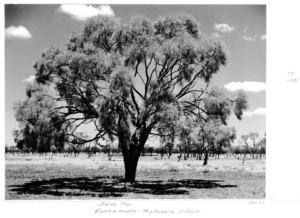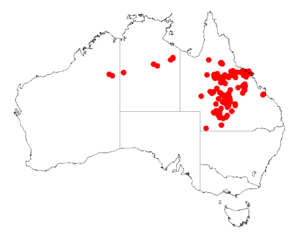Acacia tephrina facts for kids
Quick facts for kids Boree |
|
|---|---|
 |
|
| Boree tree between Thylungra and Cunnamulla in 1955 | |
| Scientific classification | |
| Genus: |
Acacia tephrina
|
| Species: |
tephrina
|
 |
|
| Occurrence data from AVH | |
The Boree (scientific name: Acacia tephrina) is a type of Acacia tree. It grows naturally only in parts of northeastern Australia. It's considered a 'least concern' species, which means it's not currently in danger of disappearing.
Contents
What the Boree Tree Looks Like
Boree trees can grow quite tall, up to about 20 meters (that's like a six-story building!). They have dark grey bark that looks flaky and cracked. Their branches are covered in soft, grey-green hairs. The tree usually grows straight up with a narrow top, and its branches often start low down on the trunk. If you cut it back, it can regrow from the stump, and new shoots (called suckers) can pop up from its roots.
Like most Acacia trees, the Boree has special leaf-like parts called phyllodes instead of true leaves. These phyllodes are evergreen and hairy. They are long and thin, about 7 to 15 centimeters long and 2 to 6 millimeters wide. They have many thin lines running along them.
When the Boree blooms, it produces groups of golden flowers. These flowers grow in small clusters of 2 to 10. Each cluster is a round ball, about 4.5 millimeters across, with 20 to 35 tiny golden flowers.
After the flowers, hairy, leathery seed pods form. These pods are long and flat, about 6.5 centimeters long and 5 to 6 millimeters wide. They have a clear edge and contain seeds arranged lengthwise. Each seed is about 5.5 millimeters long and has a small, fleshy attachment called an aril.
Where Boree Trees Grow
The Boree tree is found in eastern Northern Territory and central and southern Queensland, Australia. You can find it from places like Cresswell in the Northern Territory, all the way into Queensland. In Queensland, it grows mostly west of the Great Dividing Range. Its range stretches from Einasleigh in the north down to Cunnamulla in the south, and out to Bowen in the northeast.
Boree trees like to grow in heavy soils, including salty clay soils. They are often found in open woodlands or shrublands.
How Boree Trees Are Used
The wood from the Boree tree is hard and heavy, with a dark red-brown color. It's great for making things like fence rails, posts, and poles. It also makes excellent firewood because it burns very hot, even when it's green.
The bark of the Boree tree contains special substances called tannins. These tannins have a drying effect. Indigenous Australians traditionally used the bark to help treat stomach problems like diarrhea. They also used it as a wash for wounds, skin issues, or eye problems.
Images for kids
See Also


